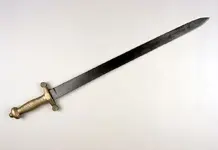Vino
Banned
Found this sword at a 1700s site...Any help would be great.
.
.

Similar to an 1856 Land Transport Corps sword (UK). Called a "cabbage cutter".
<img src="http://www.treasurenet.com/forums/attachment.php?attachmentid=1032177"/>
Sword, other ranks, Land Transport Corps, 1856 (c) | Online Collection | National Army Museum, London
But it looks too good to have been buried long.
Vino asked me to comment. The reason I had not already posted a reply about his sword is that I do not consider myself an expert in the Edged-Weapons category of relics. But being a relics dealer for nearly 40 years, I've accumulated "some" education about antique swords.
Sword-collectors commonly call the type found by Vino a "short-sword." Its very-basic design is based on a Roman Empire short-sword called a Gladius. Many slight variations have been manufactured ever since then. Therefore, as Charlie P indicated when he told Vino "the tips of the crossguard don't match [the ones on yours]," we must rely on close examination of small-ish details to correctly identify a sword's country-of-manufacture and time-period.
The basic type of short-sword found by Vino has been made from the 1700s into the 1900s by several European countries (most especially, France), as well as the USA and CSA. You'll see a lot of short-swords INCORRECTLY advertised on Ebay as being a Confederate one, but in reality the vast majority were not made in America. Again, the "small details" are hugely important in correctly identifying a sword as being Confederate-made.
Let's note some "small details" on Vino's sword:
1- The pommel (a large knob on the end of the sword's grip) has a smaller IRON knob projecting from the brass knob's base. That does not match up with any USA or CSA military short-sword. (I specified military because some short-swords have been made for Fraternal organizations.)
2- The grip portion of Vino's sword has parallel ridges. Other versions of short-sword have "fish-scales" on the grip.
3- Most versions of 1700s-1900s Military short-swords have long linear indentions (like a shallow trough) on the blade. The blade of Vino's short-sword appears to be entirely "plain."
4- On Vino's sword, there is a "plain" (not indented) flat raised disc on each end of the crossguard, AND the ends of the crossguard curve upward. Compare those two "small details" with the crossdguards on several variations of Confederate short-swords at this link:
John Sexton - Civil War Catalog
Lastly, he is are photos showing the "small details" on a US Army Model-1832 short-sword's crossguard and blade. In particular, note the indented eagle-emblem on the pommel, the raised rim on the crossguard, "fish-scales" on the grip, and the long troughs on the blade. (Enlarge the photos by clicking on once, then clicking on them again.)
